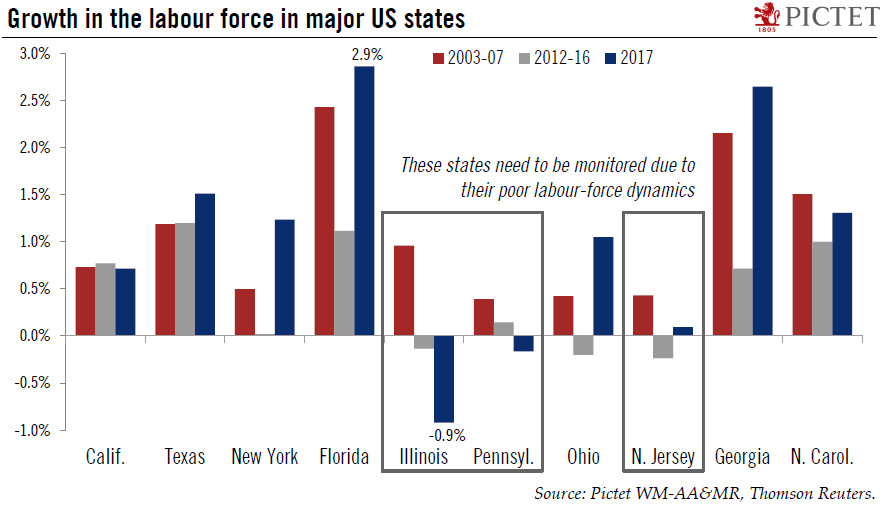Some northern US states face the challenge of a shrinking tax base.A worry persists about many US states and municipalities’ finances, especially due to rising pension costs. The recent volatility in financial markets has raised fears the situation might worsen. The need to add to the pension pot is also affecting states and municipalities’ ability to fund infrastructure investment, or even basic maintenance.A shrinking tax base is aggravating the problem in some areas. A good proxy for the health of the tax base is the growth in the labour force (technically speaking, those with a job or those actively seeking one). Among the biggest states by GDP, five are in a precarious position because they have flat-to-declining labour forces: New York, Illinois, Pennsylvania, Ohio and New Jersey.
Topics:
Thomas Costerg considers the following as important: Macroview
This could be interesting, too:
Cesar Perez Ruiz writes Weekly View – Big Splits
Cesar Perez Ruiz writes Weekly View – Central Bank Halloween
Cesar Perez Ruiz writes Weekly View – Widening bottlenecks
Cesar Perez Ruiz writes Weekly View – Debt ceiling deadline postponed
Some northern US states face the challenge of a shrinking tax base.

A worry persists about many US states and municipalities’ finances, especially due to rising pension costs. The recent volatility in financial markets has raised fears the situation might worsen. The need to add to the pension pot is also affecting states and municipalities’ ability to fund infrastructure investment, or even basic maintenance.
A shrinking tax base is aggravating the problem in some areas. A good proxy for the health of the tax base is the growth in the labour force (technically speaking, those with a job or those actively seeking one). Among the biggest states by GDP, five are in a precarious position because they have flat-to-declining labour forces: New York, Illinois, Pennsylvania, Ohio and New Jersey. But after years of meagre gains, New York and Ohio saw a spectacular resurgence in their labour forces in 2017 (+1.2% and +1.0% respectively), so they deserve the benefit of the doubt for now.
By contrast, the biggest worry is perhaps Illinois, where the decline in the labour force accelerated from 0.1% p.a. on average between 2012 and 2016 to 0.9% in 2017. The annual average number of people in the Illinois work force (based on monthly data) was 6.47mn people last year, the lowest since 2005.
Where are these taxpayers fleeing to? Mostly to the south. Florida saw a 2.9% jump in its labour force in 2017, ahead of the second-largest gainer, Georgia, with 2.6%. Texas also posted solid growth of 1.5%. Despite its economic dynamism, California saw ‘only’ a 0.7% rise in its workforce last year, in line with previous years and with workforce growth nationwide.
